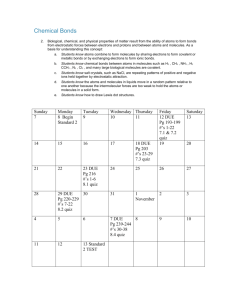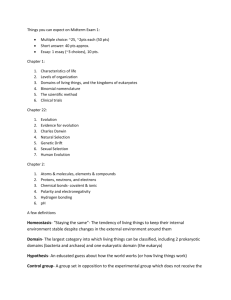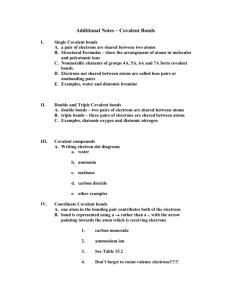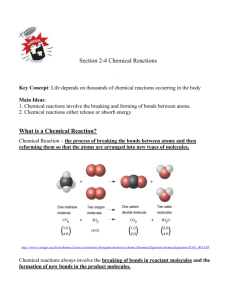Chapter 21 Chemistry of the Main Group Elements I. Structures of
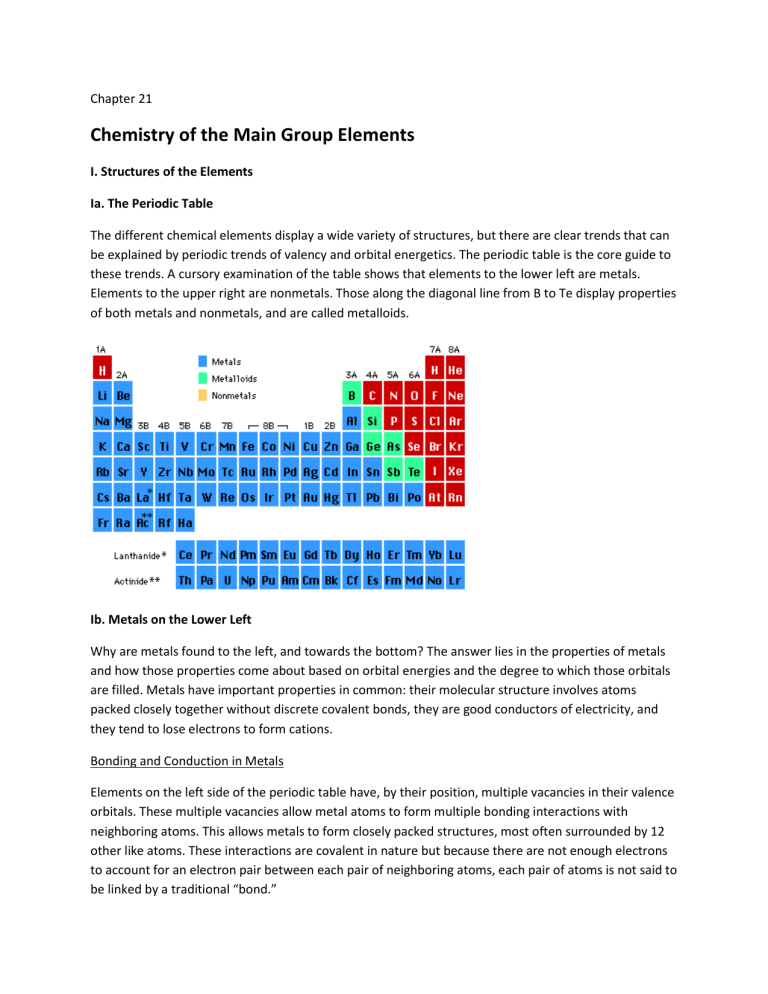
Chapter 21
Chemistry of the Main Group Elements
I. Structures of the Elements
Ia. The Periodic Table
The different chemical elements display a wide variety of structures, but there are clear trends that can be explained by periodic trends of valency and orbital energetics. The periodic table is the core guide to these trends. A cursory examination of the table shows that elements to the lower left are metals.
Elements to the upper right are nonmetals. Those along the diagonal line from B to Te display properties of both metals and nonmetals, and are called metalloids.
Ib. Metals on the Lower Left
Why are metals found to the left, and towards the bottom? The answer lies in the properties of metals and how those properties come about based on orbital energies and the degree to which those orbitals are filled. Metals have important properties in common: their molecular structure involves atoms packed closely together without discrete covalent bonds, they are good conductors of electricity, and they tend to lose electrons to form cations.
Bonding and Conduction in Metals
Elements on the left side of the periodic table have, by their position, multiple vacancies in their valence orbitals. These multiple vacancies allow metal atoms to form multiple bonding interactions with neighboring atoms. This allows metals to form closely packed structures, most often surrounded by 12 other like atoms. These interactions are covalent in nature but because there are not enough electrons to account for an electron pair between each pair of neighboring atoms, each pair of atoms is not said to be linked by a traditional “bond.”
This partially explains why metals are found on the left side of the periodic table. Here, atoms have few electrons but many orbital vacancies. As such, a single atom can share its electrons with many other atoms because those other atoms have the orbital vacancies required to accept those shared electrons.
In the same way, atoms lower on the periodic table are more metallic. Metals share electrons more readily than do nonmetals. As you move down a Group in the periodic table, say from C down through
Si, Ge, Te, to Pb, electrons in the highest filled orbitals are higher in energy and show much lower attraction to the nucleus. They can be shared more readily and the elements have greater metallic character.
The molecular orbital approach best describes these interactions. A set of valence orbitals from a set of bonded metal atoms leads to a set of molecular orbitals spread over the metal structure. When a piece of metal has many atoms, the structure has a large number of molecular orbitals over a range of energies. These closely spaced orbitals are called a “band” of orbitals, and in metals, the band of orbitals is only partially filled with electrons. That is, lower energy orbitals in the band are occupied while higher energy orbitals are vacant.
The combination of closely spaced orbtials in a partially filled band leads to the highest filled orbital being very closely spaced energetically to the lowest energy vacant orbital. This in turn means that electrons need only gain a very small amount of energy to move from one orbital to another. This small energy barrier to electron movement is the reason metals are good conductors of electricity.
Formation of Cations
Although metal atoms have multiple valence orbital vacancies, they tend to lose electons in their interactions with other atoms, forming cations. This comes about because of orbital energy trends across each period in the periodic table. Moving across a period from left to right, nuclear charge (Z) increases. As electrons are added to the valence shell, they repel one another, increasing shielding (S).
The effective nuclear charge (Z*)- the sum effects of nuclear positive charge attracting electrons and shielding electrons repelling valence electrons- increases moving left-to-right because each added electron does not allow shield the full added 1+ nuclear charge of the added proton. As the effective
nuclear charge increases, the attraction of the outermost electrons to the nucleus increases, and the energy of the valence orbital decreases. Therefore, the highest energy valence orbitals are found toward the start (left side) of each period. Electrons found in these orbitals are most easily lost, which is why metals tend to form cations.
Na has low Z*, and therefore high orbital energies. Ar has high Z*, and therefore low orbital energies.
Ic. Molecular Structures of the Nonmetals
Unlike metals, nonmetal atoms are bonded to one another via traditional 2-electron bonds. Lewis structures of the p-block elements of the 2 nd and 3 rd periods are shown in Figure XX. Note that
some elements form structures with multiple bonds, some with only single bonds. Some elements form small, discrete molecules, others form extended structures. Two factors control molecular structure of the elements: the number of orbital vacancies that could be filled and the ability to form pi bonds to a neighboring atoms. The table below indicates the number of orbital vacancies, the number of bonds needed to form to fill each atom’s octet.
Group Number
Number of Orbital
Vacancies
Number of Bonds
Needed to
Complete Octet
4A
4
4
5A
3
3
6A
2
2
7A
1
1
8A
0
0
The number of possible bonds plays an important role in determining element structures. As you move from right to left on the periodic table, atoms can form more bonds and the structures those elements take become more complex and often more extended.
The structures of some elements become clear here. The Group 8A noble gases do not form molecules.
They exist as monatomic species because they have no valence orbital vacancies the can be used to form bonds to other atoms. The halogens need only one bond to complete their octets, and form diatomic molecules with a single bond linking the two atoms.
The structural picture becomes more complex as we move left to Groups 6A and below. Oxygen forms two allotropes, O
2
and O
3
, each of which contains an O=O double bond. Contrasting this is S, which forms a number of allotropes based on rings of singly bonded S atoms, and a polymeric form containing long chains of singly bonded S atoms. Why does O form small molecules when S forms larger extended structures? The answer lies in the size of the atoms and their ability to form pi bonds.
Bonds form when orbitals on adjacent atoms overlap. Sigma bonds can form between atoms of any size because those bonds form between orbitals pointed at each other directly between the two atom’s nuclei. There is no way that those two orbitals cannot overlap well. Pi bonds, on the other hand, form from side-to-side overlap of orbitals that lie parallel to each other. If the two atoms are large, these parallel orbitals cannot overlap well and pi bonds do not form.
Recall that the sizes of atoms decrease moving left to right across a period in the periodic table and increase moving down a group. S lies below O in Group 6A and is larger than O. Therefore O-O pi bonds can form but S-S bonds do not. Therefore, S handles its need to form two bonds by forming single bonds to two other S atoms. O, on the other hand, forms a double bond to a single other O atom.
Given a pool of unbonded atoms, energetically, entropy favors formation of more, smaller molecules.
Enthalpy favors molecules with stronger bonds. In cases where relatively strong pi bonds can form, resulting in smaller molecules, entropy “wins” and small, multiply bonded molecules are formed. When pi bonds are weak, enthalpy “wins” and extended structures containing only sigma bonds are formed. S forms larger extended structures with each S atom forming single bonds to two other S atoms- this leads to chains of S atoms; O forms small molecules.
The same controlling factors are seen in Group 5A. Nitrogen is small, can form N-N pi bonds, and exists as small N
2
molecules that have 1 sigma and 2 pi bonds. Phosphorus is larger and cannot form P-P pi bonds. P therefore exists as one of three allotropes. In each allotrope, the P atoms are singly bonded to
3 other P atoms. White P contains small, tetrahedral P
4
molecules. These have unstable 60 o bond angles and P
4
is a highly reactive form of P. Red P is based on chains of linked “opened” P4 units. This form releases about half of the 60 o bonds and is substantially more stable than white P. White P4 is favored by entropy but disfavored by enthalpy when compared to Red P. That Red P is the more stable form tells us that in this case, the enthalpic considerations are more important than are the entropic ones. That is, for P, bond strength wins out over an entropy preference for small molecules.
Carbon and silicon need four bonds to complete its octet and forms only extended structures, but still continue the trend. Carbon forms allotropes that have only single bonds (diamond) as well as allotropes containing both sigma and pi bonds (graphite and the various fullerenes we will examine later in this chapter).
All of this is summarized right here:
You may have noticed that boron has not been described here. B is unique among the elements in that it is a nonmetal that has many orbital vacancies and is relatively low in electronegativity. It gets its own section later in the chapter.
II. Oxides
The oxides of the nonmetals follow structural trends similar to those found in the elements themselves.
Their structures are shown in Figure 21.XX. Again, structures are dependent on the number of bonds an element can form as well as its ability to form pi bonds, but in this case pi bonds to an oxygen atom instead of a second atom of the same element. The halogens, Group 7A, form mainly compounds of the form OX
2
, where X is the halogen. Thus, OF
2
, OCl
2
, and OBr
2
. A more complex oxide, O
3
Cl-O-ClO
3
also exists. These are all small molecule oxides, favored both in terms of bonding (enthalpy) and having small molecules (entropy).
In Group 6A, oxygen forms O
2
and O
3
with other O atoms. Sulfur forms two small molecule oxides: SO
2 and SO
3
. Where elemental S did not form S-S pi bonds and therefore made larger structures with each S
bonding to two other S atoms, S-O pi bonds are possible because the S-O bond distance is smaller than the S-S bond distance. In Group 5A, N forms sigma and pi bonds to O and thus forms small oxides. P tends to favor single bonds over double bonds because the P-O bond length is long enough to make pi bonds relatively weak. P forms a series of oxides that contain P-O-P bridges (called oxo bridges).
This trend mimics that seen for element structures. As you move left and down the periodic table, the ability to form pi bonds decreases and the tendency to form bridges, extended structures increases.
Group 4A exemplifies this trend. Carbon forms two principal oxides: CO and CO2. Both contain C-O pi bonds and are favored entropically due to the small molecules formed. The oxide of Si has a formula analogous to carbon dioxide: SiO
2
. The most important form of this is the mineral quartz. Structurally, Si is too large to form Si-O pi bonds and therefore forms only single bonds. Because Si forms four bonds, each Si is bonded to four different O atoms. Because the formula contains 2 O atoms for each Si atom, it is necessary for every O atom to bridge between two Si atoms. This forms an infinite 3-dimensional extended structure.
Boron, again, is handled in a separate section, but for now, let it be stated that B is too large to form B-O pi bonds and singly bonds to multiple O atoms.
III. Halides
The compounds between the nonmetals and the halogens are, for the most part, pretty boring. None of the halogens form pi bonds and the structures observed are those expected based on VSEPR theory.
Some of the larger elements exhibit expanded valence structures, which lends at least some interest to this section. We restrict our view to Periods 2 and 3 of Groups 4A-6A and cover compounds between different halogens later. Also later is a special section on compounds of the noble gases. Note that a general “halogen” is often referred to with the symbol “X.”
Group/Period 4A
2 CX
4
and other extended halogenated organics, e.g.
C
3
F
8
5A
NF
3
NCl
3
NBr
3
NI
3
6A
OF
2
OCl
2
OBr
2
3 SiF
4
SiCl
4
SiBr
4
SiI
4
PF
PCl
3
PBr
3
, PF
3
, PF
5
5
, PBr
5
SF
2
, SF
4
, SF
6
The compounds formed are those you would expect based on standard Lewis structures, except that P and S show expanded valence structures. Phosphorus forms the standard PX
3
molecules in which each P atom has 8 valence electrons in its Lewis structure. The expanded valence PX
5
molecules have a P atom that has 10 valence electrons in its Lewis structure. Sulfur forms the octet-obeying SX
2
molecules, for which each S atom has 8 valence electrons in the Lewis structure. S also forms SX
4
(which uses 10 valence electrons) and SX
6
(which uses 12 valence electrons).
The tendency to form expanded valence structures begins in the 3 rd period of the periodic table because these central atoms make use of vacant 3d orbitals in their bonding. The tendency increases moving leftto-right because the energies of orbitals decreases, making those vacant orbitals more attractive to bonding electrons. Thus, P forms PF
5
but N does not form NF
5
. Likewise, P forms expanded valence structures, but Si does not.
If we expand our view out further left in the periodic table we see an interesting effect. The table below shows the melting points of the most common compound with F of the 3 rd period elements.
1A
Compound KF
858 Melting point, o C
2A
CaF
2
1418
3A
AlF
3
1291
4A
SiF
4
-90
5A
PF
3
-151
6A
SF
4
-121
7A
ClF
-155
Notice the large break between group 3A and 4A, when we move from Al to Si. This effect is due to the change from creating ionic compounds, which have strong ion-ion attractions and high melting points, to molecular covalent compounds, which have only relatively weak intermolecular forces. KF, CaF
2
and
AlF
3
are ionic. Those to the right are molecular covalent.
IV. Boron
IVa. Elemental Boron and Boron Basics
Boron has a valence electron configuration of 2s22p1. As such it has 5 valence orbital vacancies. Can boron therefore form 5 bonds? We think not. Instead, boron tends most often to form three bonds to other atoms, but sometimes is found with four. Elemental boron takes the form of B12 icosoahedra (is that right?-bv). In these, each B atom is bonded to three other B atoms and the structure is completed by forming a rough sphere.
taken from WebElements; is this right?-bv
Boron tends to
IVb. Metal Borides
Boron forms an interesting series of ostensibly ionic compounds with metals where the metal is the cation and boron, in one form of another, is the anion. These range in formula from being almost pure metal to being almost pure boron. image of this, better than the one I’m thinking of.-bv
Some
IVc. Boron Oxides, Hyrdoxides, and Halides
IVd. Boranes
V. Carbon
Va. The Myriad Motifes of Carbon
diamond, lonsdalite, graphite, balls and tubes. Entropy vs. enthalpy for all.
Vb. Cave Chemistry
VI. Silicon
VIa. Silica and Silicates
VIb. Silicones
VIc. Silicon-Based Semiconductors
VII. Phosphorus
VIII. Oxygen
Ozone Chemistry
IX. Chlorine
